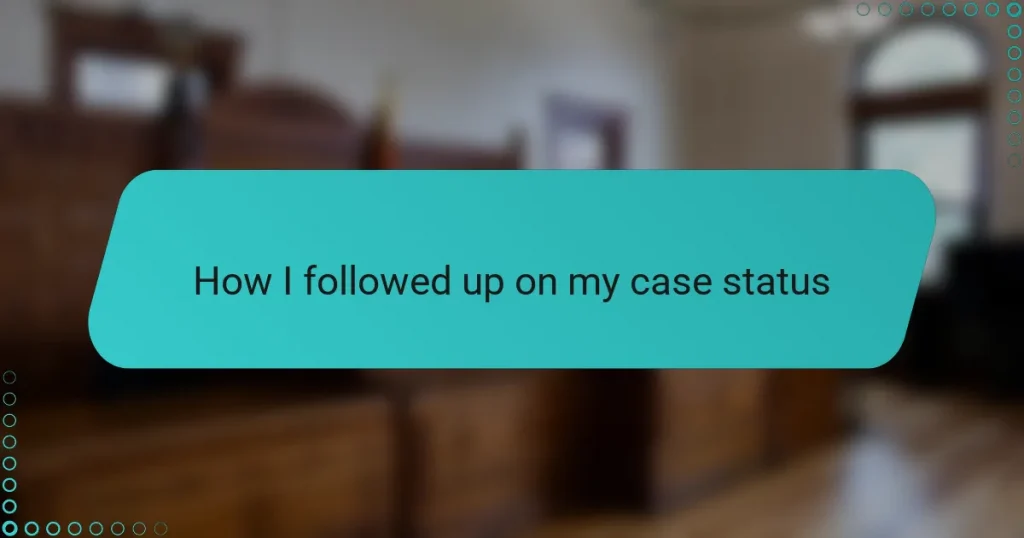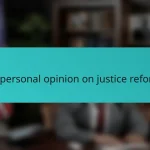Key takeaways
- Understanding case status terminology is crucial for managing expectations and reducing anxiety during legal processes.
- Utilizing official court portals, direct communication with clerks, and consulting with attorneys can provide clarity on case updates.
- Having essential information, such as case numbers and specific questions, makes inquiries more efficient and productive.
- Maintaining detailed records and setting regular check-ins can create a manageable follow-up routine and foster a collaborative relationship with legal representatives.
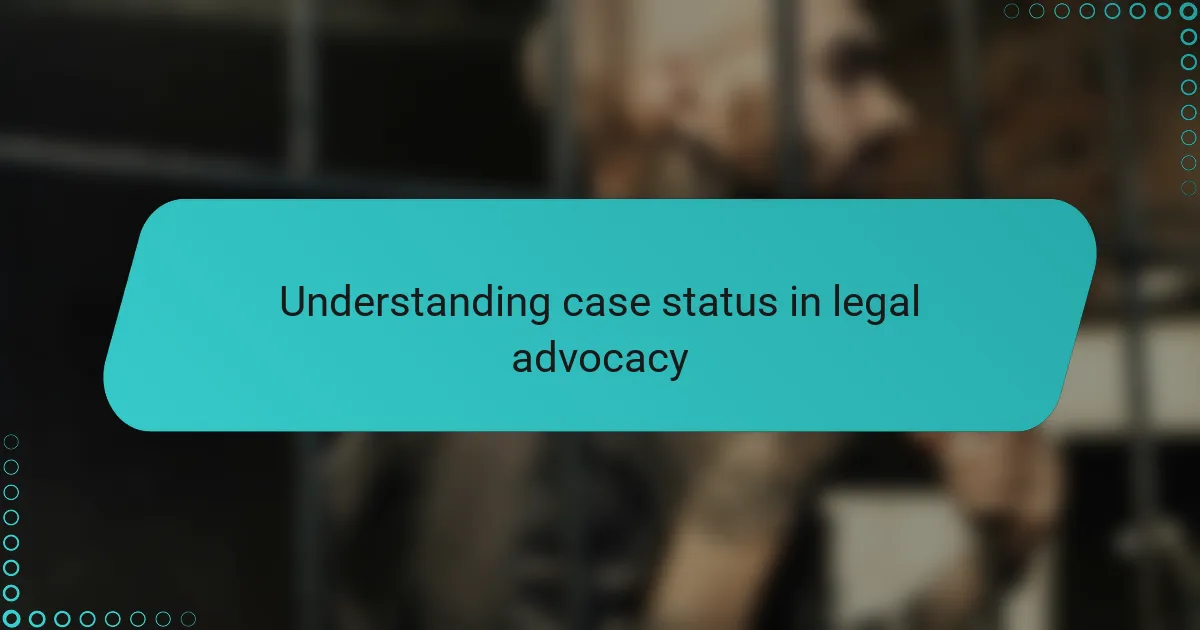
Understanding case status in legal advocacy
Understanding case status in legal advocacy often feels like deciphering a complex code. From my experience, the terminology alone—“filed,” “pending,” “adjudicated”—can be overwhelming if you don’t know what each stage means. Have you ever found yourself staring at an update and wondering, “What does this actually mean for my case?”
I remember feeling that exact confusion during a particularly tense period in my own case journey. It wasn’t just about waiting; it was about trying to grasp what progress truly looked like. Recognizing the significance of each status update helped me manage my expectations and reduce a lot of unnecessary anxiety.
Knowing the case status isn’t just about clocks and court calendars; it’s about understanding where you stand in a process that deeply affects your life. When you get familiar with the stages, it becomes easier to decide when to reach out for updates or take further action. Isn’t that clarity what we all need when navigating legal battles?
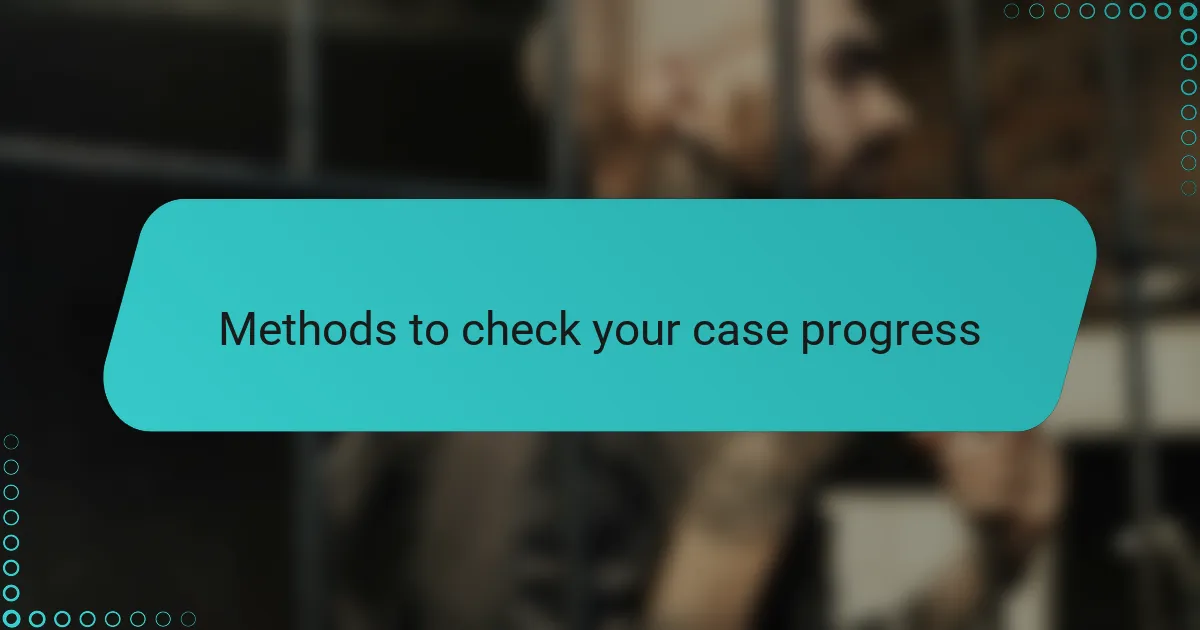
Methods to check your case progress
One method I found incredibly useful was regularly checking the court’s online portal. It felt empowering to log in and see my case docket number, filings, and scheduled hearings right at my fingertips. Have you tried this digital self-service? It can be a game-changer when you want immediate, up-to-date information without the wait.
Sometimes, though, the online updates seemed sparse or technical, which left me just as confused. That’s when I picked up the phone and called the clerk’s office directly. Speaking to an actual person gave me clarity and reassured me that my case was moving forward, even when the screen said little.
Another route I leaned on was communicating with my attorney. Their inside knowledge helped interpret vague status updates and explain what next steps to expect. It made me realize how valuable a trusted guide can be in the labyrinth of legal terminology and procedures. Have you felt that relief when you finally get a straight answer from someone who knows the ropes?
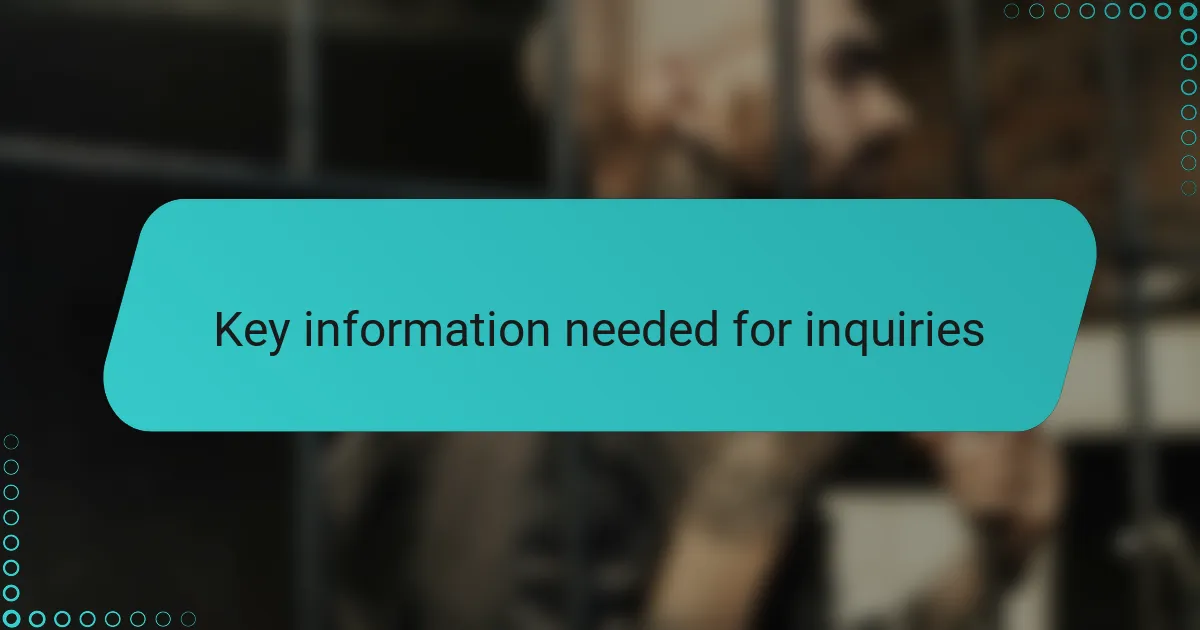
Key information needed for inquiries
When I first started making inquiries, I quickly learned that having key information on hand made all the difference. Things like your case number, full names of the parties involved, and the date the case was filed became my essentials. Without these details, I found that even simple questions could lead to long, frustrating pauses or redirected calls.
I recall a time when I called the court clerk without my case number, thinking I could just explain my situation. That call was a maze of verifying identities and double-checking records, stretching my patience thin. Do you know how much easier it is when you simply provide the case docket number upfront? It’s like giving the person on the other end a clear map straight to your case.
Beyond just identifying information, understanding what specific aspect of your case you’re asking about matters a lot, too. Whether it’s hearing dates, recent filings, or decisions, being precise saved me from ambiguous answers or endless hold music. Have you ever felt stuck on a vague update? Pinpointing your question is the first step to cutting through the noise.
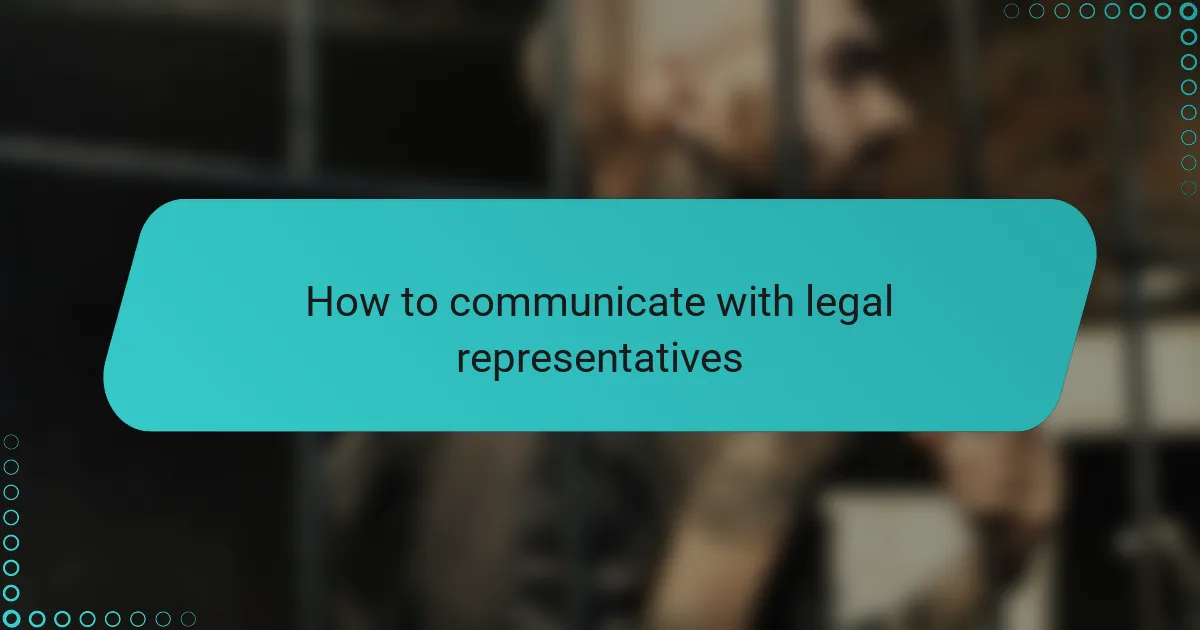
How to communicate with legal representatives
Communicating with legal representatives can feel daunting at first, but I found that starting each conversation with a clear, specific question made all the difference. Instead of asking broad things like “How’s my case?” I learned to say, “Can you update me on the hearing date or recent filings?” This precision not only saved time but gave me answers that actually mattered.
I also remember how important it was to respect their busy schedules; I made it a habit to ask the best times and preferred methods to reach them. Have you ever felt guilty calling your attorney repeatedly? Setting boundaries helped me maintain a professional relationship without feeling like I was bothering them.
Lastly, being open about your own concerns and feelings helped build trust. I once shared my anxiety about delays, and my lawyer responded with reassurance and a clearer timeline. That honest dialogue made me feel seen and supported, not just like another file on their desk. Have you tried being transparent in your communications? It might surprise you how much it improves the experience.
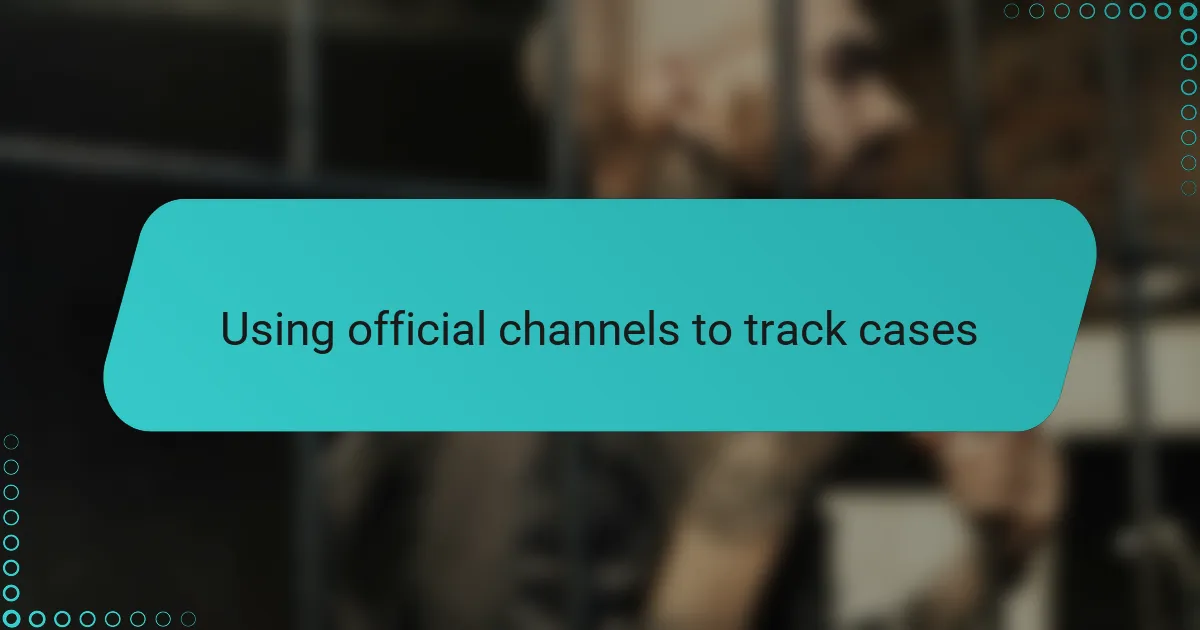
Using official channels to track cases
Using official channels to track cases was a game-changer for me. I found that courts and government agencies often offer dedicated portals or helplines where you can get real-time updates. Have you ever logged in to one of those sites and felt a mix of relief and frustration—relief to see your case moving, frustration if the information was too barebones or technical?
What struck me most was how important it was to know exactly where to look and whom to contact. I remember one instance when I naively tried multiple channels before learning that the court clerk’s office was the best source for clearing up confusing status notes. Picking up the phone and talking to a clerk felt like finding a lighthouse in a fog of legal jargon. Doesn’t it help when you have a trusted official point of contact to cut through the noise?
Of course, these official channels aren’t just about checking boxes—they’re about reclaiming some control during a process that often feels out of your hands. Each time I reached out through the right channel and got a clear update, I felt a bit more empowered and less alone. Have you experienced the boost that comes simply from knowing where you stand because you took that proactive step?
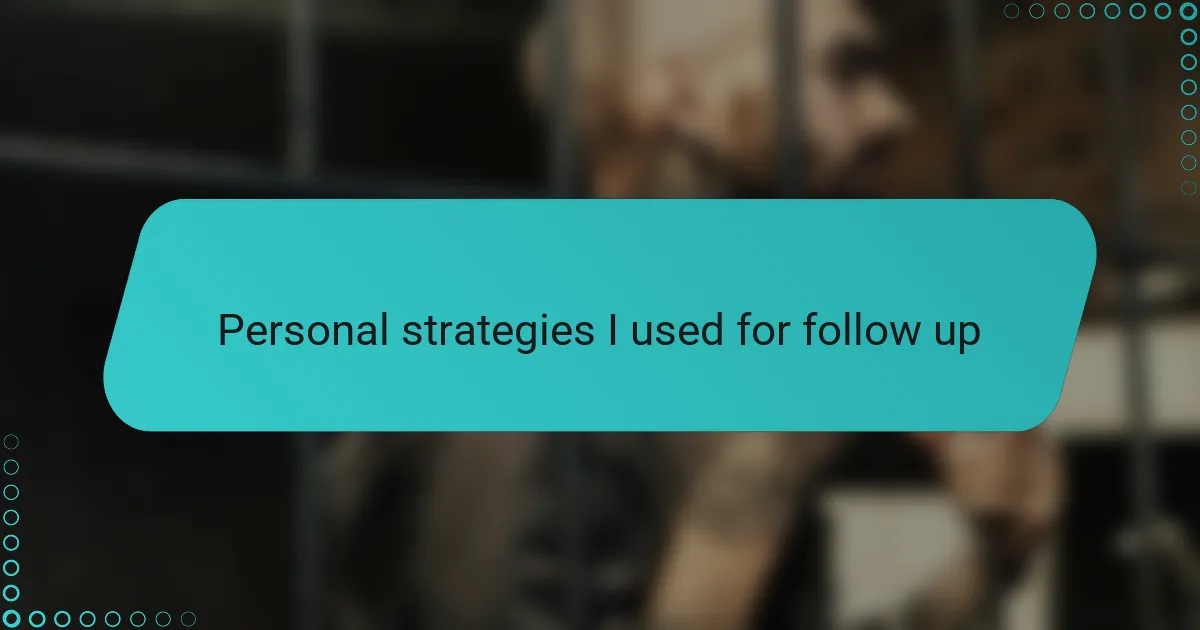
Personal strategies I used for follow up
One personal strategy I relied on was keeping a detailed, chronological log of each interaction—phone calls, emails, and meeting notes. I found that having this record reduced my anxiety because I could track what had been discussed and what follow-ups were needed. Don’t you think it’s easier to stay calm when you have a clear roadmap instead of relying just on memory?
I also made a habit of setting regular reminders to check in, whether weekly or biweekly, depending on the case progress. This steady rhythm helped me avoid the temptation to either obsess over the case status or forget to follow up altogether. Have you noticed how consistency can turn a stressful process into something more manageable and predictable?
Another tactic was tailoring my questions to the person I was contacting. For example, when speaking with the court clerk, I focused on procedural updates; when talking with my lawyer, I dove into strategy and implications. That distinction made each conversation more productive and respectful of their time. Have you found that knowing exactly what to ask—and who to ask—can make follow-ups feel less like a chore and more like a collaboration?
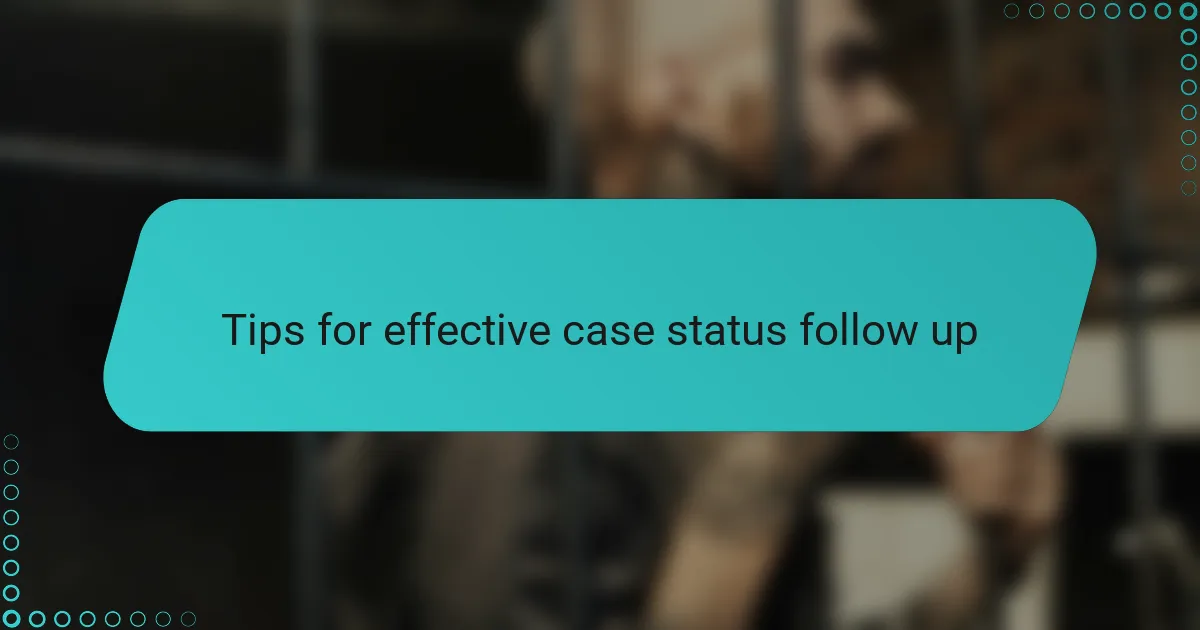
Tips for effective case status follow up
One tip that truly helped me stay on top of my case was treating follow-ups like a professional exchange rather than a passive wait. I made it a point to prepare my questions in advance, clear and focused. Have you ever felt that awkward pause when you fumble through what to ask? Crafting precise questions not only saved time but gave me answers that actually mattered.
From my experience, timing also plays a crucial role. I learned not to bombard contacts with constant messages, but instead set regular, reasonable intervals for check-ins. This approach eased my anxiety because it balanced being proactive without overwhelming the busy court staff or my attorney. Don’t you think it’s easier to stay calm when you have a steady routine rather than reacting impulsively?
Finally, showing appreciation and respect during each interaction made a world of difference. A simple “thank you” or acknowledging how busy everyone was kept conversations positive and opened doors for better cooperation. I noticed people were more willing to help when treated as partners in the process, not just as gatekeepers of information. Have you tried adding a bit of warmth to your follow-ups? It can turn a stressful process into a surprisingly pleasant collaboration.
